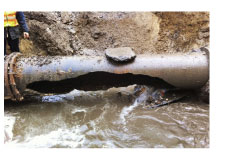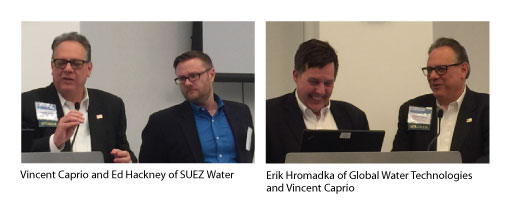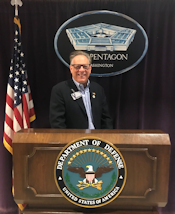Water 2.0 and OSTP Celebrate World Water Day March 22nd
Posted on April 4th, 2016 | No Comments »
In observance of UN World Water Day 2016, the nation’s water experts convened at the White House and the Water 2.0 Digital Transformation for the Water Industry Conference on March 22nd in Washington, DC. The groups focused on fixing America’s crumbling water infrastructure, with an emphasis on putting new innovative digital technology to work. Here is a summary of the White House Water Summit.
 Unlike electricity, water is a utility without a centralized grid or unified governance. America has 50,000 water systems within 5,000 water authorities that operate independently of each other. Estimates of water loss through leakage are up to 50% in urban areas, and 20% overall. Leaks go undetected for decades or sometimes not at all. Pipes range from lead to copper to pvc and even wood, and the older ones do not necessarily break first. An estimated 850 water main breaks occur each day, and countless broken meters lead to piracy and lost revenues. The nation’s antiquated infrastructure has not seen major improvements since the 1930s under President Franklin D. Roosevelt. Yet still, when we turn on a faucet we expect clean water the same way we expect safe electricity when we flip a switch.
Unlike electricity, water is a utility without a centralized grid or unified governance. America has 50,000 water systems within 5,000 water authorities that operate independently of each other. Estimates of water loss through leakage are up to 50% in urban areas, and 20% overall. Leaks go undetected for decades or sometimes not at all. Pipes range from lead to copper to pvc and even wood, and the older ones do not necessarily break first. An estimated 850 water main breaks occur each day, and countless broken meters lead to piracy and lost revenues. The nation’s antiquated infrastructure has not seen major improvements since the 1930s under President Franklin D. Roosevelt. Yet still, when we turn on a faucet we expect clean water the same way we expect safe electricity when we flip a switch.
Among the thought leaders was leading water and technology transformation expert Dr. Ken Russell of iTalent, who has been instrumental in advancing the dialogue for 20 years. “We tend as a society not to fix things until they break – like our cars,” he said. “When a school’s drinking water in Flint, Michigan gets tainted, that’s undeniable evidence of a broken infrastructure. Our country has a 70-80 year old system that is only going to get worse. President Obama and The Office of Science & Technology Policy (OSTP) did a great job by inviting a range of experts into the White House, including town councilmen, municipal leaders, legislators, technologists, and scientists. To complement this historical event, Water 2.0 is putting the most relevant new technology in front of the right people.”
It would take an investment of $400 billion over a 10 year period to repair America’s crumbling water infrastructure. Sufficient data and advanced digital technologies can be deployed to detect and pinpoint breaks, repair leaks, test and purify water, recycle and reclaim waste, and conserve usage by an order of magnitude. Here is a recent New York Times article of interest: Water Is Broken. Data Can Fix It. Within the last 2 years I have seen a surge of innovation in the water industry as never before, from start-ups to mid-sized companies, to major players like GE and Cisco. We now have the technology to modernize the system, but the government needs to allocate the funds, and that takes public support. Without that, we will continue to go crisis to crisis, and can expect more disasters like what happened this year in Flint.
In the tradition of American ingenuity, engineers, scientists and innovators in the public and private sector are developing new digital analytic systems, sensors and software that can revolutionize the water industry much like innovation has revolutionized energy efficiency and renewables, phones, electronics, communications, transportation, healthcare and banking. In an era when we are probing space for signs of water, we are well served to also focus on what we need to survive here on Earth.
The water industry was slower to adopt new technologies because of its complex nature and the fact that the responsibility falls under every level of government, none of which can call the shots. By convening scientists, engineers, entrepreneurs, software developers, utility managers, policy makers, government leaders and CEOs for decades, we are now finally coming out of the dark ages and entering the digital era, hopefully in time to avoid catastrophe.
To be successful, any approach to fixing America’s complex water delivery system, including wastewater reclamation, must not only be comprehensive, but informative. In an election year when some candidates are on national television dismissing the critical role of the EPA and the Clean Water Act, without which America’s water would not be safe, it is important to educate the public on why investment in our water infrastructure should be a priority.
Social media and advanced communication tools can play an important role in raising awareness among the general public, and also in sharing data and best practices among water professionals in an urgent and timely manner. Becky Scott of Cisco works to maximize the power of media technology for water-related information transfer. “The situation in Flint, for example, was brought to the public eye because of a concentrated effort in social media by concerned members of the public and journalists,” she said. “And with a more connected water industry, these situations could be unearthed and addressed before they become a crisis.”

Today, people can get instant data on all aspects of their lives, including personal devices that can monitor every move and vital sign. There is no excuse for waiting a month for the water bill to arrive to see how much water a household or business has consumed. Progressive companies like Global Water Technologies (OTC:GWTR) are developing new “smart water” tools that can meter usage in real time and help consumers understand where they can conserve to save money. These smart water tools offer data for personal use and across the entire distribution system. According to the company’s CEO and Our Water Counts contributor, Erik Hromadka, “As water prices rise and efficiency becomes more important, smart water tools empower everyone to be part of the solution at the local, state and national levels.”
Emerging technologies to measure water flow, pressure, pH, conductivity, turbidity, temperature, chemicals, pollutants, and other data points, including regulatory compliance, have sparked job growth making water-related big data one of the nation’s fastest growing economic sectors. Water 2.0 has become a watering hole for professionals, which has enabled the cross-pollination of technologies.
On World Water Day, March 22nd, the Administration convened representatives from Federal, State, regional, local and tribal governments, the private-sector and other stakeholder groups at the White House to showcase and explore how a public-private water strategy is making progress. For further information, click here.
For details on the Water 2.0 Conference – Digital Transformation for the Water Industry, or to learn more about the digital revolution in the water industry, click here.
Digital transformation provides a clear path to solving America’s water infrastructure problems.





